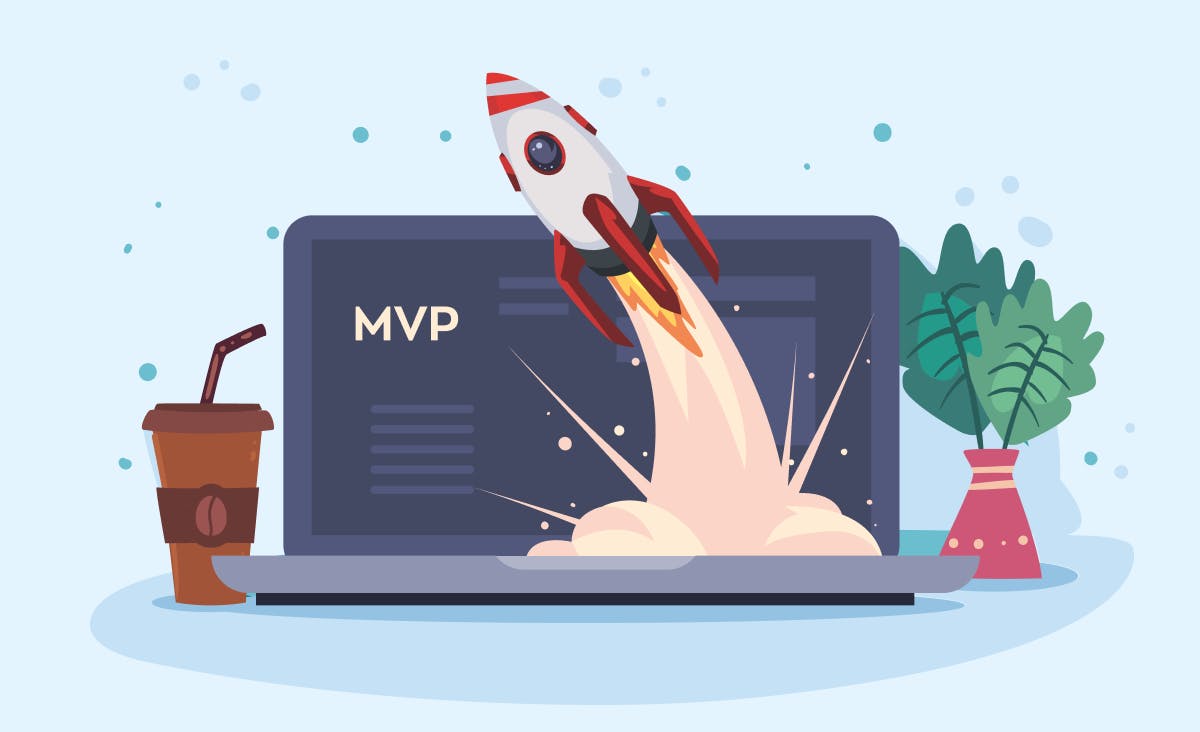What is an MVP in software development?
MVP stands for the minimum viable product. In a few words, it’s a released product with just enough features to enter the market. You still may ask a reasonable question, why make an MVP instead of providing users with an app with all functionality and a perfect design?
At the first sight, we may consider we have all the cards when presenting a scrupulously developed application to the audience. Nevertheless, it is more of a self-deception. To be successful in digital product development, the very first action to take is checking a product-market fit, i.e. getting the maximum info with the least expenses, which often requires a parallel study of customers’ needs while engineering an app.
So, an MVP is neither a product with all-ready features and a high risk of wasting money nor fast iterations running in circles trying to understand what a customer needs. An MVP is a product with a minimum set of features needed to start learning from the early adopters.
What is the specificity of MVP in software development?
As MVP implies building a product with the minimum features to resolve a customer problem, it’s important to choose in which form the MVP should be developed. For example, if you know your target audience tends to use mobile phones, then you should go for mobile development. Hence, you’ll have to keep in mind that, once the app is developed, you will need to undergo acceptance procedures to get into the app stores. And to be present in both App Store and Google Play in a short time, you’ll need experts in multi-platform development technologies.
Web MVPs can be deployed more quickly since no certification is required. Then you can launch a web app rendered for mobile first and proceed to adapt it for other platforms later on. Did you know that Instagram has only recently started working on a desktop version? Not earlier than 2022 they introduced a messenger desktop version. No wonder they did so, as the app was originally focused on instantly sharing moments of everyday life.
Thus, it’s important to make sure you have a deep understanding of your audience to make informed decisions. Not to miss out on such important milestones, let’s proceed to the discussion of the sequence of MVP development.
If you have an MVP idea, we will find the best way to develop it. Learn more about our MVP development services and bring your product to market in just a few months.
What are the steps for making an MVP?
According to the theory of startup management by Eric Reis, an optimal cycle of creating a product consists of three repeating processes: building, measuring, and learning. MVP is a mechanism that starts the cycle, and it should be made so that it can be evaluated.
At the beginning of its era, Facebook impressed investors with two indicators: the time spent by active users on social networks and the speed of its spreading across the student campuses. That’s how they drew $500,000 of venture capital without having any income yet. A year later, they got $12,7M more. All they needed were indexes of value and growth that any startup should be looking for. But how to start creating a minimum viable product with potential, and how can it be measured?
Step 1. Understand who your target audience is. Without this crucial information, there is no way you will be able to choose what features to build first. Let’s say you’re going to build a yoga app. Who’s going to be your target audience? It may be older adults looking to support their mobility and health. Or it can be young adults who’re into social sharing. In the first case, you’ll focus on building convenient personalized practices, while in the second, you may consider adding elements of social networks.
Step 2. Go and observe. To define the value of the product, the first thing to do is to see what people truly need, and what problems they have. The best way to find it out is through communication in the form of an in-depth interview, not third-party marketing research or stats. In case you’re planning to make an app for a grocery shop, talk to those who go shopping regularly.
Step 3. Pick a core feature and test it. When you understand what your future customers’ issue is, try the mechanism that’s going to help them even before developing a digital product or make it extremely simple. In his book The Lean Startup, Eric Ries gives a brilliant example of a startup called Food on the Table, whose CEO took a close look at the needs and shopping habits of a single customer before automating any processes.
Step 4. Collect feedback on the mechanism and only then proceed to the development. When thinking about a well-known example, the Dropbox case comes to mind. What Drew Houston did was just present stakeholders with a video showing how file synchronization is going to work. It allowed him to attract more people who believed in the product’s future.
Step 5. Based on the target audience’s reaction, define the metrics crucial for the company’s growth, such as user registration rate, demo version popularity, customer experience, and others. The aim is to build MVP in such a way that the metrics finally reach the ideal indicators.
Then, knowing the key metrics, a startup team doesn’t develop a product blindly but rather works on features that increase important numbers. Nevertheless, MVP creation doesn’t always follow an ideal plan and has its own pitfalls to be aware of.
What to consider when making an MVP
Probably the most important thing is that the first version of a product that has made it to the market doesn’t have to be perfect. The willingness to change the world is great, but what’s more important is to let imperfections be, keep on testing ideas, and develop a product further. If a raw product threatens the company’s reputation, an MVP can be released and tested under another name.
As a result of perfectionism, another issue that most startups face is too many functions included in the first version. What is really worth concentrating on is the core feature that directly solves the problem. A solution is to get rid of any processes and tasks that prevent testing the heart of the matter.
Another danger is to make one hypothesis your idée fixe and not try other ideas that might be more successful. Before building an MVP of an app, it’s better to make several prototypes to test them and make sure you’ve chosen the right direction. By agreeing on the design and essential features of the MVP beforehand, a startup can minimize the amount of time and money spent in the long term.
One of the most spread fears about building an MVP is confidentiality. What if competitors decide to steal the idea? The solution here is not to keep a project’s concept a secret, but to be aware that you’re going to finish the full testing cycle faster than anyone else.
And the last and most important consideration is that an entrepreneur should be ready for the MVP to fail. No matter how scrupulously the product is built and designed, there is always a chance that the target audience won’t buy it.
Read another article on the topic PoC vs Prototype vs MVP: A Complex View.
Benefits of developing an MVP
You get valuable data, providing you with insights about the product. What kind of data you may get? Qualitative data tells what people like and dislike, while quantitative data tells how many users use the product and think it’s valuable. The first one helps to get rid of unnecessary features and focus on important things; the second one measures your success and helps to define key features as well.
You avoid building a product that lacks demand. Nobody wants to build an app that nobody wants. Imagine spending money and resources to develop a product that doesn’t make a product-market fit. MVP allows startups to measure their feasibility with minimum risks and expenses before it’s too late.
You maximize the value of each dollar spent. May sound crazy for something at the early stage of development. However, if you perceive hypothesis testing as a valuable lesson that invests in the product’s indispensability and competitiveness, then the cost of this learning process is worth every dollar.
You create a mechanism for receiving feedback to shape future development. By establishing a feedback loop earlier, it is easier to implement users’ requirements. Feedback starts guiding your development strategy rather than making you rewrite the whole app.
You can simplify the process of getting investments. To convince stakeholders that your startup is a worthwhile investment, an impressive pitch alone might not be convincing. However, because an MVP is a tangible product that has already been launched, investors can see the perspectives of a product by analyzing real numbers.
You significantly increase speed to market. Getting evangelists’ feedback as soon as possible is more important for a startup than bringing a perfect product to the market after several years of development. An MVP reduces this timeline and allows a business to pull all its efforts into adjusting to the target audience’s real needs.
Wrapping up
No matter how important an MVP is, it is just a part of the product development process. It gives an irreplaceable start to progress through learning from feedback, measuring the metrics, and implementing improvements. What goes next? Eternal iterations to make a product better for your customer and, hopefully, lead the way to creating something outstanding.

